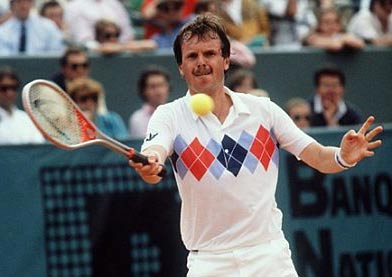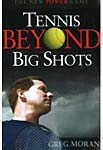| TennisOne Lessons Great Lessons from the Past Greg Moran It’s not often that one gets the opportunity to be on the court with a world class tennis player. I had such an opportunity many years ago when I was invited to practice with the great Polish pro, Wjotek Fibak.
A consistent top ten player in the late 70’s and early 80’s, Fibak won 67 titles during his thirteen year career. He was a quarterfinalist at Roland Garros, Wimbledon and the U.S. Open and in 1976 he captured the Australian Open doubles title with Aussie Kim Warwick. As we began to warm-up, Fibak’s strokes were smooth as silk – a stark contrast to mine which produced one nervous mis-hit after another. After a few minutes, my hand stopped shaking and I was able to sustain a rally. Soon after, Fibak took off his warm-up jacket and said, “Let’s get to work.” We drilled for a while and then Wjotek (as he told me to call him) suggested we play a few games. Forty-five minutes later we walked off the court, having played two sets. Or was it three? Anyway, the fact that he destroyed me wasn’t surprising. It was the way he did it that opened my eyes and taught me several lessons that today, over thirty years later, are helping my students win matches. Lesson # 1: Extend Your Shot Tolerance Shot tolerance is a high tech term for patience and Fibak had a boatload of it. During our practice match, he consistently hit the ball 1-2 feet inside the baseline, patiently moving me around the court. He soon learned that after four or five shots, my low shot tolerance would kick in. I’d begin to panic and ultimately hand him the point as I attempted a low percentage shot which usually resulted in an error.
Most players have a limit as to how many balls they’re willing to hit to win their points. Many, particularly those with a “hit big to win big” approach to strategy, max out after only two or three balls cross the net. The next time you’re at the courts pick a match and watch for a few minutes. As the players move through their points, you’ll frequently see one or the other try a high risk shot in an attempt to end the point. They may try to rip a groundstroke winner when pulled wide or try a drop shot from three feet behind the baseline. That player, either physically or psychologically, has reached the end of their shot tolerance. They’ve had enough and are going to end the point, one way or the other. How many balls are you willing to hit to win a point: 3, 5, 40? Winning players are not afraid of long rallies and are willing to hit as many balls as it takes. At the 2009 ATP World Tour Finals held in London, Russia's Nikolay Davydenko (a.k.a. The Ironman) showed tremendous shot tolerance as he defeated Roger Federer, Rafael Nadal and Juan Martin del Potro on his way to capturing the most prestigious title of his career. Here are two great drills to help you improve your shot tolerance:
Note: As always, be sure to check with your physician before beginning any new fitness program. While improving your own shot tolerance should be a priority, also pay attention to how many balls your opponent is willing to hit to win a point. As I said, most players have a limit and if you can force them beyond it, you’ll be in the driver’s seat. I always use the first 2-3 games of a match to figure out my opponent’s shot tolerance. I simply keep the ball in play and see what happens. Shot tolerance will vary from player to player but often I'll find that after 2-3 shots my opponent has reached their limit and simply has to go for a winner. He then tries a high risk shot that more often than not, hands me the point. Lesson # 2: Take Proper Advantage of the Opportunity Ball During my better-played points with Fibak, I was able to extend my shot tolerance and, for a while, the points remained neutral. We both moved the ball around the court, patiently probing and prodding each other’s game. Not surprisingly, I would inevitably blink first and present him with what I call an “opportunity” ball. An opportunity ball is a shot that allows you to take control of the point. It could be an opponent’s short shot or a groundstroke in your strike zone that you have a bit of extra time to prepare for. If you respond properly to an opportunity ball, you’ll immediately put your opponent on the defensive and be in a great position to ultimately capture the point.
A common mistake that players make is to view an “opportunity ball,” as an opportunity to end the point. Not feeling any pressure, they wind up, swing harder and attempt to win the point with one big shot. Unfortunately, their big shot frequently results in an unforced error, much to the delight of their relieved opponent who knew that they were in trouble. My second lesson that day was found in Fibak’s reaction to an opportunity ball. Once he had a groundstroke he could take control of the point with, he immediately became aggressive. However, not in the way you might expect. Like a shark smelling blood in the water, Fibak began to circle his prey. He stepped into the ball and patiently began to carve me up. He pushed me left and right as well as up and back. Still displaying tremendous shot tolerance, he changed spins and speeds and had me scrambling to survive. It was just a matter of time before I either missed or gave him something he could easily put away. He used this same approach when he came to the net. Many players assume that once they take the net, every volley is a put-away shot. Shot tolerance and waiting for the opportunity ball is just as important at the net as it is in the backcourt. As I lobbed and hit passing shots, Fibak patiently hit volleys and overheads, waiting until another opportunity ball came his way. At the net, an opportunity ball could be a short high volley or an easy overhead. When that shot came, he ended the point. However, he seldom used pace. Instead, he immediately charged closer to the net and hit to an open area of the court.
An opportunity ball could arise in the second shot of a point or the 22. That’s where shot tolerance again enters the equation. Be aware of when a point is neutral and learn to recognize the opportunity ball. When it comes, remember that:
When you do your consistency and shot tolerance building drills, look for shots that you would call “opportunity balls.” These will be shots that you have a bit more time to prepare for, are in your strike zone, and you could begin to dictate play with. The key is to differentiate which balls you should play with a neutral approach and which to take control of the point. Lesson # 3: The Final (and most important) Lesson As I drove home, I thought about my practice match with the great Pole. The score didn’t interest me as I was fully aware that Fibak, one of the best players in the world, could beat me any one of a dozen ways. Instead, I focused specifically on how I lost points and how I could use that information when playing the mere mortals that I normally faced. First, I realized that the vast majority of our points ended with me committing an error, either forced or unforced. Fibak didn’t blow me off the court with huge shots and he didn’t paint lines. In fact, he hit very few clean winners. Whether he could or couldn’t was irrelevant. He didn’t need to and neither do you. Fibak patiently and purposely allowed me to beat myself and, and in the process, showed me that, over and above everything else, tennis is a game of errors! It doesn’t matter if it’s Fibak playing McEnroe in the 80’s, Federer vs. Nadal in 2010 or Smith vs. Jones at the public courts tomorrow morning, tennis matches are usually won by the player who commits the fewest number of errors.
Winning players understand this. Sure, they come up with the unbelievable shot from time to time but they know that, over the course of a long match, most points are going to end with someone committing an error. Instead of focusing on hitting “winners” they work on strategies designed to let (or force) their opponent lose the point Andre Agassi was a master of letting his opponents beat themselves. During his recent tour to promote his great book “Open,” Agassi was asked what Brad Gilbert brought to his game. He responded by saying that Gilbert taught him to “accept his opponent’s gifts.” Another word for “gifts” is errors. For years I tried to win my points by hitting big flashy winners. I’d hit some, miss many more and did not win very often. After playing with Fibak, I began to work on minimizing my number of errors and look for ways to let my opponents lose points. Not surprisingly, my results began to improve. Remember, there are no degree of difficulty points in tennis. It doesn’t matter if you paint a line or your opponent hits the ball into the net, you only get one point. Focus on minimizing your errors. This can be done by increasing your shot tolerance and executing high percentage shots (see the “Strategy” section of TennisOne for some great articles on percentage tennis). Then, look for ways to force your opponent to miss. If you’re playing an opponent with low shot tolerance, your strategy could be as simple as returning 3-4 balls each point. Better players will force you to become more creative and to look for weaknesses in their game. Sure, the tennis ball may be moving much faster than when Wjotek Fibak played the pro tour but his lessons of shot tolerance, the proper approach to opportunity balls and learning to accept an opponent’s “gifts” are evergreen. They helped him win in the 70’s and 80’s and they’ll help you win in 2010 and beyond! Your comments are welcome. Let us know what you think about Greg Moran's article by emailing us here at TennisOne.
Tennis Beyond Big Shots presents a bold back-to-the-future approach. A new game that moves away from power and big shots yet is more lethal to opponents than any booming serve. Greg Moran shows players of all ages and abilities that, with simple and small changes, you can not only maximize your tennis wins and play longer, but also have much more fun doing it. Click link to purchase Greg Moran's book, Tennis Beyond Big Shots. Mansion Grove House is pleased to announce that in May, 2008, they will release the second edition of Tennis Beyond Big Shots. Written by Greg Moran, the book (which includes a new chapter) was Amazon's #1 new tennis release in 2007. |

